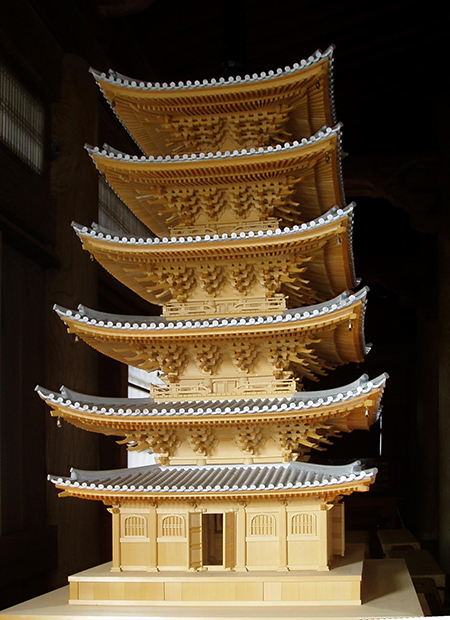

鎌倉の建長寺をみてきましたが最後にふたたび武家と禅宗の関係について。
武士という「階層」はアジアでは日本でだけ成立した。
朝鮮では両班という階層ができたけれどあれは古代以来の王朝国家での
支配層が身分固定されたものであって
中国の科挙制度とも連動するような身分制度なのだと思う。
ヨーロッパと同様の「騎士」という階層意識と共通する武士という存在は
アジアでは日本でだけ成立し、その階層が権力を握った。
健全な「封建制度」が完全に根付いたという意味ではアジアで特異な社会。
インド哲学者、仏教学者、比較思想学者・中村元氏は『日本人の思惟方法』において、
〜民族性からくる思惟傾向に応じた日本と中国の仏教の性質の相違について、
禅宗においても日本と中国とでは教義が同一でなく、
中国人の思惟方法が非論理的かつ苛酷残忍であることを反映するかたちで、
中国の禅宗も隠遁的・独善的であるのに対し、
日本人の思惟方法が寛容と愛情を強調することを反映するかたちで、
日本の禅宗も宥和的・慈悲的なものへと変化しているのだという。
中国文化において禅は、明時代以降の衰退や元来の多民族国家という社会機構、
また近代の列強支配や戦後の文化大革命などによって、文化「浄化」が
常に一定期間で発生し人々の生活に定着することはなかった〜とされている。
こういうアジア思想史は今日の国際関係の基調をも示しているでしょう。
武家という新興の階層が権力をまとっていくときに
その宗教的表現として禅宗が選択されたのには相互に共通するものがあった。
武士というのは戦士であり常在戦場で常に死を意識する存在。
より内面的な宗教心、克己心強化の方向で精神面は発展していった。
禅宗のもつ内観的姿勢が好ましく受容されたのだろうけれど、
たまたま中国大陸で新興の宗派として盛んだったことも連動した。
鎌倉で武士道と禅宗の接合は始められたが権力が足利氏に移転し
全国支配の合理性から京都に幕府を開いたことから
京都の宗教文化として禅宗はメインカレントになっていった。
夢窓疎石と足利直義の強い紐帯など、武家と禅宗は相互浸透していった。
ただし、武家でも平氏は西国武士の側面が強く禅には傾倒していない。
また、鎌倉政権誕生に深く関わった奥州藤原氏も中尊寺など
宗教心の篤い政権だったが、古代以来の伝統的宗教を尊崇している。
奥州という遠隔地にありながら黄金の経済力で王朝国家最先端の
浄土思想による仏教空間を造営している。
しかし全国的に成立した武権では鎌倉ー足利主流が支配するところとなり
封建主義での各地域支配権を積極的に擁護する思想として
禅宗が武家社会の規範的存在になっていく。
こうした地域自治的な封建主義は日本人に合理的個人主義を涵養し、
明治にいたっての西欧文明期にもその受容マインド基盤になった。
禅宗−武士道の涵養した「個人主義」が西洋文明受容期にも
その精神的基盤を提供し、社会発展を促進させたといえるのだろう。
English version⬇
[Bushido and Zen / Japanese-style things Kenchoji, Kamakura-10]
I have seen Kenchoji Temple in Kamakura, but finally about the relationship between the samurai family and Zen Buddhism.
The “class” of samurai was established only in Japan in Asia.
In the challenge, there was a class called Yangban, but that was the dynasty nation since ancient times.
The ruler’s status is fixed, and it is also called the Imperial Examination System in China.
I think it’s a social division system that works together.
It is common with the class consciousness such as “knight” similar to Europe.
The existence of a samurai was established only in Japan, and that hierarchy took power.
A unique society in Asia in the sense that a sound “feudal system” has completely taken root.
Hajime Nakamura, an Indian philosopher, Buddhist scholar, and comparative philosopher, wrote in “The Japanese Way of Thinking”.
~ Considering the difference in the nature of Buddhism between Japan and China according to the thought tendency that comes from ethnicity,
Even in Zen Buddhism, the doctrine is not the same between Japan and China,
Reflecting that the Chinese way of thinking is illogical and cruel and brutal,
While Chinese Zen Buddhism is also secluded and self-righteous,
In a way that reflects the Japanese way of thinking that emphasizes tolerance and affection.
It is said that Zen Buddhism in Japan is also changing to appeasement and mercy.
In Chinese culture, Zen is a social organization that has declined since the Ming dynasty and was originally a multi-ethnic nation.
In addition, cultural “purification” has been promoted by the rule of modern powers and the Cultural Revolution after the war.
It is said that it always occurred in a certain period of time and did not settle in people’s lives.
This history of Asian thought may also show the keynote of today’s international relations.
When the emerging class of samurai takes power
Zen Buddhism was chosen as its religious expression because it had something in common.
A samurai is a warrior who is always aware of death on the battlefield.
It developed in the direction of strengthening the inner religious spirit and selfishness.
The introspection of Zen Buddhism may have been well accepted, but
It happened to be linked to the fact that it flourished as an emerging sect in mainland China.
In Kamakura, this kind of joining of Bushido and Zen Buddhism was started, but Bushido was transferred to Ashikaga.
Because the shogunate was opened in Kyoto because of the rationality of national rule
It became the main current as a religious culture in Kyoto.
The samurai family and Zen Buddhism penetrated each other, such as Muso Soseki and Ashikaga Tadayoshi’s strong ties.
However, even in the samurai family, Mr. Taira has a strong aspect of the Saigoku samurai and is not devoted to Zen.
In addition, Mr. Fujiwara Oshu, who was deeply involved in the birth of the Kamakura administration, also joined Chusonji Temple.
Although it was a religion-minded government, it reveres traditional religions since ancient times.
The state-of-the-art dynasty with golden economic power despite being in a remote area called Oshu
We are building a Buddhist space based on the Pure Land Buddhism.
However, in the nationwide military power, Kamakura-Ashikaga mainstream will dominate.
As an idea that actively defends the control of each region in feudalism
Zen Buddhism becomes the normative existence of the samurai society.
Such community-autonomous feudalism cultivates rational individualism for the Japanese,
It became the basis of its acceptance mind even during the Western civilization period leading up to the Meiji era.
Zen Buddhism- “Individualism” cultivated by Bushido is also in the period of acceptance of Western civilization
It can be said that it provided the spiritual foundation and promoted social development.
Posted on 12月 25th, 2021 by 三木 奎吾
Filed under: 住宅マーケティング, 日本社会・文化研究







コメントを投稿
「※誹謗中傷や、悪意のある書き込み、営利目的などのコメントを防ぐために、投稿された全てのコメントは一時的に保留されますのでご了承ください。」
You must be logged in to post a comment.